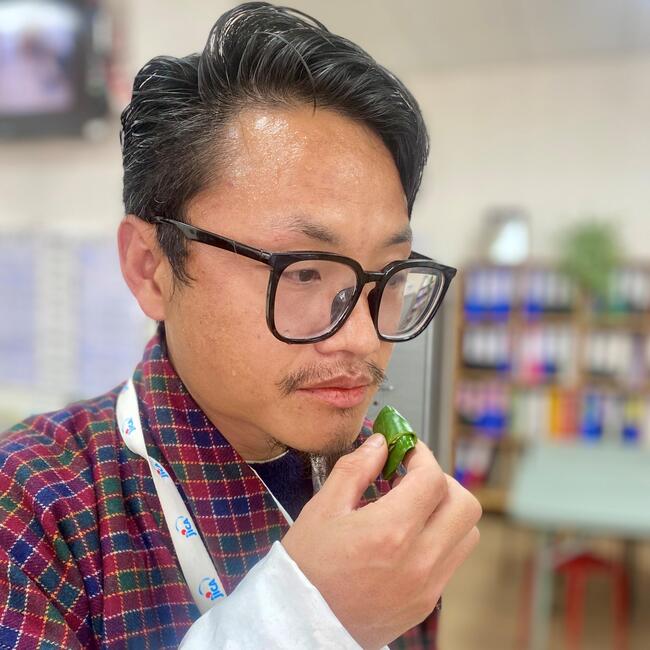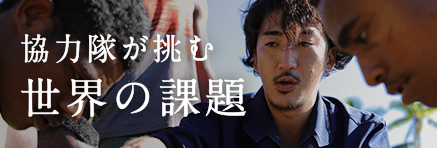2025/04/07 Mon
Unraveling the Dragon Kingdom
Doma: A Bhutanese Tradition with a Bite|ドマ: ブータンの伝統的な嗜好品


My introduction to doma was a childhood experience that sparked a lifelong habit.
I remember watching my grandfather enjoy it after every meal, a sort of "dessert" ritual.
私がはじめてドマと出会ったのは幼少期で、それが今でも続く習慣になりました。
祖父が毎食後にドマを楽しんでいるのを覚えています。
一種の「デザート」の儀式のようでした。
One day, he offered me some. Nervously, I took the areca nut (the doma itself), a touch of lime, wrapped it in a betel leaf, and chewed.
The sensation was immediate – a warming rush spreading through my body, my face flushing red.
That was my first taste of doma, and the beginning of a tradition I now share.
ある日、祖父が私にドマを勧めてくれました。
緊張しながら、私はビンロウの実(ドマそのもの)とライムを少し取り、キンマの葉で包んでかみ砕きました。
その感覚はすぐに感じられました。体が温かくなり、顔が真っ赤になりました。
それが、私が初めてドマを味わったときの経験で、今私が共有している伝統の始まりでした。
Doma, also known as trozey (a conversation starter), is more than just a snack in Bhutan.
It's a cultural cornerstone, a symbol of hospitality, and a ubiquitous presence in Bhutanese life.
While historically it may have been a gift from the elite to the common people, today it's enjoyed by everyone, regardless of social standing.
ドマは、トロゼイ(会話のきっかけ)としても知られ、ブータンでは単なるおやつではありません。
文化の礎であり、おもてなしの象徴であり、ブータン人の生活のあらゆる場面に存在します。
歴史的には、エリート層から庶民への贈り物だったようですが、今日では社会的地位に関係なく、誰もが楽しんでいます。

This seemingly simple treat is a combination of three key ingredients: doma (areca nut), pani (betel leaf), and tsu-ney (lime). Together, they form what's known as a "betel quid" or doma khamto in Dzongkha.
The areca nut, the seed of the Areca catechu palm, and the betel leaf, a vine of the Piper betel plant, are combined to create this unique chew.
この一見シンプルな嗜好品は、ドマ(ビンロウの実)、パニ(キンマの葉)、ツネイ(ライム)という主に3つの材料を組み合わせたものです。
これらを合わせると、ゾンカ語で「ドマ カムト」と呼ばれるものになります。
ビンロウの実(ヤシ科アレカ属のヤシの種子)とキンマの葉(コショウ科キンマ属の植物のつる)を組み合わせて、このユニークな嗜好品は作られています。
Doma is deeply woven into the fabric of Bhutanese society.
It's offered to guests as a sign of welcome, shared among friends and strangers, and enjoyed on all occasions.
ドマはブータン社会に深く根付いています。
来客には歓迎のしるしとして差し出され、友人や見知らぬ人の間で共有され、あらゆる機会に楽しまれています。
Traditionally, it was chewed for the energy boost and warmth it provided, particularly important in Bhutan's high-altitude environment.
This effect is likely due to the areca nut's natural alkaloids, which release adrenaline and can create a feeling of euphoria.
伝統的に、ドマはエネルギーの増強やそれによって得られる温かさのために噛まれ、特にブータンの高地においては重要なものでした。
この効果は、アドレナリンを放出し、多幸感を生み出すビンロウの実の天然アルカロイドによるものと考えられています。
However, this long-standing tradition comes with potential health concerns.
The alkaloids, particularly arecoline, can be addictive. Doma is one of the most popular psychoactive substances globally, ranking fourth after nicotine, alcohol, and caffeine. While research is ongoing, the World Health Organization (WHO) classifies betel nut as a carcinogen, with studies linking its use to oral and esophageal cancers.
しかし、この長年の伝統には健康上の懸念が伴います。アルカロイド、特にアレコリンは中毒性があります。
ドマは、ニコチン、アルコール、カフェインに次いで、世界で4番目に多く消費されている精神活性物質です。
まだ研究中ですが、世界保健機関 (WHO) はビンロウの実を発がん性物質に分類しており、その使用と口腔がん・食道がんとの関連を示す研究結果もあります。
Other risks include oral submucous fibrosis, gum irritation, tooth decay, and staining.
There are also concerns about increased risks of cardiovascular disease, metabolic syndrome, obesity, and other cancers.
その他のリスクとして、口腔粘膜下線維症、歯肉の炎症、虫歯、着色などがあります。
また、心血管疾患、メタボリック シンドローム、肥満、その他のがんのリスク増加も懸念されています。

Doma's history extends far beyond Bhutan.
Its use dates back thousands of years in South and Southeast Asia and the Pacific Islands.
In Guam and other Pacific islands, evidence suggests its consumption as far back as 2,000 years.
Today, the WHO estimates that around 600 million people worldwide chew betel nut in some form.
ドマの歴史はブータンをはるかに超えた地域に及んでいます。
南アジア、東南アジア、太平洋諸島では、何千年も前から使われてきました。
グアムやその他の太平洋諸島では、2,000 年前にはすでに消費されていたという証拠があります。
今日、WHO は、世界中で約 6 億人が何らかの形でビンロウの実を噛んでいると推定しています。
The origins of doma consumption in Bhutan remain somewhat shrouded in mystery.
While some consider it an imported culture, no one knows exactly when or how it became so ingrained in Bhutanese culture. It's often assumed that the practice was adopted from neighboring Indian states like Bengal and Assam, where betel nut grew abundantly.
ブータンにおけるドマの起源は、いまだ謎に包まれています。
輸入文化だと考えている人もいますが、いつ、どのようにしてブータン文化に深く根付いたのか、正確には誰も知りません。
ビンロウの実が豊富に生育するベンガルやアッサムなどの近隣のインド諸州から取り入れられた、とも考えられています。
Historically, doma was a luxury item in Bhutan, restricted to the aristocracy due to the need for imports.
Today, with its widespread availability, doma is accessible to everyone, a testament to its enduring cultural significance. While enjoying this unique tradition, it's also important to be aware of the potential health risks associated with its consumption.
歴史的に、ドマはブータンでは贅沢品であり、輸入が必要なため貴族階級のみが購入できるものでした。
今日では、広く入手可能となり、誰もが楽しめるようになりました。
これは、この文化的価値が長く続くことの証でもあります。
このユニークな伝統を楽しみながらも、その摂取に伴う潜在的な健康リスクにも注意することが重要です。
SHARE





